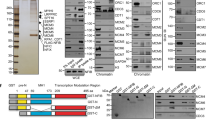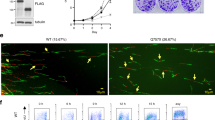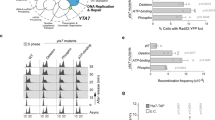Abstract
Ini1/hsnf5 gene encodes INI1 protein, a chromatin remodeling factor associated with the SWI/SNF complex. In yeast, this complex modifies chromatin condensation to coactivate various transcriptional factors. However, in human, little is known about the SWI/SNF complex and INI1. To elucidate cellular functions of ini1, we constructed a recombinant adenovirus (AdexHA-INI1) capable of overexpressing INI1 in ini1-deficient cells. AdexHA-INI1 produced intranuclear INI1 in three ini1-deficient cell lines, changed their morphology, and decreased the proportion of viable cells. Flow cytometry and a BrdU incorporation assay showed that after the infection, growth of these cells was partially arrested at G1. In two of the three ini1-deficient cell lines, apoptosis was found to occur after the infection, as detected by the presence of cleaved poly (ADP-ribose) polymerase. To determine functional domains of INI1, we constructed plasmids expressing INI1 and its deletion mutants, which were used for a colony formation assay. Repeats 1 and 2 of INI1 were found to be required to suppress the growth of the three ini1-deficient cell lines. The results support the hypothesis that ini1 is a tumor suppressor gene and suggest a novel link between human SWI/SNF chromatin remodeling complex and apoptosis.
This is a preview of subscription content, access via your institution
Access options
Subscribe to this journal
Receive 50 print issues and online access
$259.00 per year
only $5.18 per issue
Buy this article
- Purchase on Springer Link
- Instant access to full article PDF
Prices may be subject to local taxes which are calculated during checkout







Similar content being viewed by others
Abbreviations
- MRT:
-
malignant rhabdoid tumor
- PARP:
-
poly (ADP-ribose) polymerase
- MOI:
-
multiplicity of infection
- CPE:
-
cytopathic effect
References
Biegel JA, Zhou JY, Rorke LB, Stenstrom C, Wainwright LM, Fogelgren B . 1999 Cancer Res. 59: 74–79
Bochar DA, Wang L, Beniya H, Kinev A, Xue Y, Lane WS, Wang W, Kashanchi F, Shiekhattar R . 2000 Cell 102: 257–265
Brand A, Covert A . 2001 Gynecol. Oncol. 80: 99–103
Brodie SG, Deng CX . 2001 Trends Genet. 17: S18–S22
Cheng SW, Davies KP, Yung E, Beltran RJ, Yu J, Kalpana GV . 1999 Nat. Genet. 22: 102–105
Duriez PJ, Shah GM . 1997 Biochem. Cell. Biol. 75: 337–349
Garvin AJ, Re GG, Tarnowski BI, Hazen-Martin DJ, Sens DA . 1993 Am. J. Pathol. 142: 375–380
Graham FL, Smiley J, Russell WC, Nairn R . 1977 J. Gen. Virol. 36: 59–74
Horton RM, Hunt HD, Ho SN, Pullen JK, Pease LR . 1989 Gene 77: 61–68
Kalpana GV, Marmon S, Wang W, Crabtree GR, Goff SP . 1994 Science 266: 2002–2006
Kitamura Y, Ishikawa T, Okui N, Kobayashi N, Kanda T, Shimada T, Miyake K, Yoshiike K . 1999 J. Acquir. Immune Defic. Syndr. Hum. Retrovirol. 20: 105–114
Klochendler-Yeivin A, Fiette L, Barra J, Muchardt C, Babinet C, Yaniv M . 2000 EMBO Rep. 1: 500–506
Lee D, Sohn H, Kalpana GV, Choe J . 1999 Nature 399: 487–491
Muchardt C, Reyes JC, Bourachot B, Leguoy E, Yaniv M . 1996 EMBO J. 15: 3394–3402
Muchardt C, Sardet C, Bourachot B, Onufryk C, Yaniv M . 1995 Nucl. Acids Res. 23: 1127–1132
Murphy DJ, Hardy S, Engel DA . 1999 Mol. Cell. Biol. 19: 2724–2733
Okui N, Kobayashi N, Kitamura Y . 1998 J. Virol. 72: 6960–6964
Ota S, Crabbe DC, Tran TN, Triche TJ, Shimada H . 1993 Cancer 71: 2862–2872
Peebles PT, Trisch T, Papageorge AG . 1978 Pediat. Res. 12: 485–
Phelan ML, Sif S, Narlikar GJ, Kingston RE . 1999 Mol. Cell. 3: 247–253
Roberts CW, Galusha SA, McMenamin ME, Fletcher CD, Orkin SH . 2000 Proc. Natl. Acad. Sci. USA 97: 13796–13800
Rozenblatt-Rosen O, Rozovskaia T, Burakov D, Sedkov Y, Tillib S, Blechman J, Nakamura T, Croce CM, Mazo A, Canaani E . 1998 Proc. Natl. Acad. Sci. USA 95: 4152–4157
Scherer WF, Syverton JT, Gey GO . 1953 J. Exp. Med. 97: 695–
Sekiguchi M, Shiroko Y, Suzuki T, Imada M, Miyahara M, Fujii G . 1985 Biomed. Pharmacother. 39: 372–380
Sevenet N, Sheridan E, Amram D, Schneider P, Handgretinger R, Delattre O . 1999 Am. J. Hum. Genet. 65: 1342–1348
Sudarsanam P, Cao Y, Wu L, Laurent BC, Winston F . 1999 EMBO J. 18: 3101–3106
Sudarsanam P, Winston F . 2000 Trends Genet. 16: 345–351
Versteege I, Sevenet N, Lange J, Rousseau-Merck MF, Ambros P, Handgretinger R, Aurias A, Delattre O . 1998 Nature 394: 203–206
Wang W, Cote J, Xue Y, Zhou S, Khavari PA, Biggar SR, Muchardt C, Kalpana GV, Goff SP, Yaniv M, Workman JL, Crabtree GR . 1996 EMBO J. 15: 5370–5382
Whitehouse I, Flaus A, Havas K, Owen-Hughes T . 2000 Biochem. Soc. Trans. 28: 376–379
Wong AK, Shanahan F, Chen Y, Lian L, Ha P, Hendricks K, Ghaffari S, Iliev D, Penn B, Woodland AM, Smith R, Salada G, Carillo A, Laity K, Gupte J, Swedlund B, Tavtigian SV, Teng DH, Lees E . 2000 Cancer Res. 60: 6171–6177
Wu DY, Krumm A, Schubach WH . 2000 J. Virol. 74: 8893–8903
Acknowledgements
We thank Yasuhide Hayashi (Department of Pediatrics, University of Tokyo) for KYM-1 and TM87-16 cells. We are grateful to Tadahito Kanda, Aikichi Iwamoto, Tetsuya Nakamura, Takashi Odawara (DID, IMS UT), Kunito Yoshiike (National Institute of Health, Thailand), and Hiroshi Yoshikura (NIID) for critical reading of the manuscript. This work was supported by grants to Y Kitamura from the Ministry of Health, Labour and Welfare; the Japan Human Sciences Foundation; and the Ministry of Education, Culture, Sports, Science and Technology Agency. K Ae is a recipient of a Resident Fellowship from the Japanese Foundation for AIDS Prevention.
Author information
Authors and Affiliations
Corresponding author
Rights and permissions
About this article
Cite this article
Ae, K., Kobayashi, N., Sakuma, R. et al. Chromatin remodeling factor encoded by ini1 induces G1 arrest and apoptosis in ini1-deficient cells. Oncogene 21, 3112–3120 (2002). https://doi.org/10.1038/sj.onc.1205414
Received:
Revised:
Accepted:
Published:
Issue Date:
DOI: https://doi.org/10.1038/sj.onc.1205414
Keywords
This article is cited by
-
Human SNF5 arming of double-deleted vaccinia virus shows oncolytic and cytostatic activity against central nervous system atypical teratoid/rhabdoid tumor cells
Cancer Gene Therapy (2021)
-
Inhibition of MYC by the SMARCB1 tumor suppressor
Nature Communications (2019)
-
Loss of IGFBP7 expression and persistent AKT activation contribute to SMARCB1/Snf5-mediated tumorigenesis
Oncogene (2014)
-
A novel angiomatoid epithelioid sarcoma cell line, Asra-EPS, forming tumors with large cysts containing hemorrhagic fluid in vivo
BMC Research Notes (2013)
-
Throwing the cancer switch: reciprocal roles of polycomb and trithorax proteins
Nature Reviews Cancer (2010)



